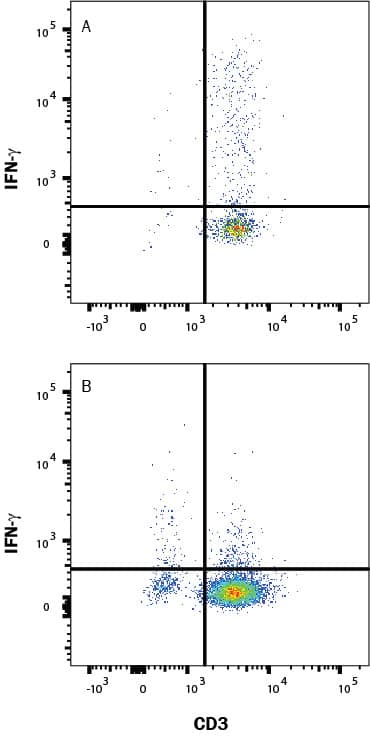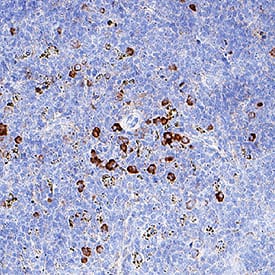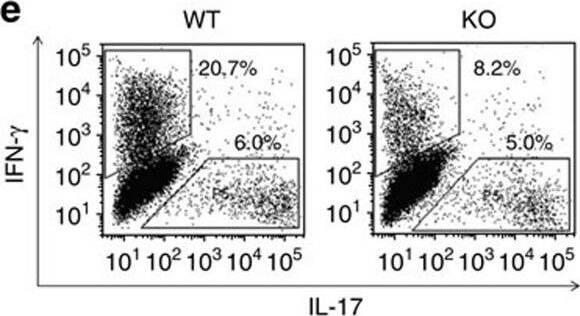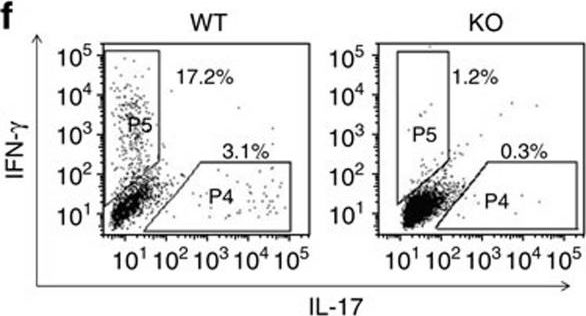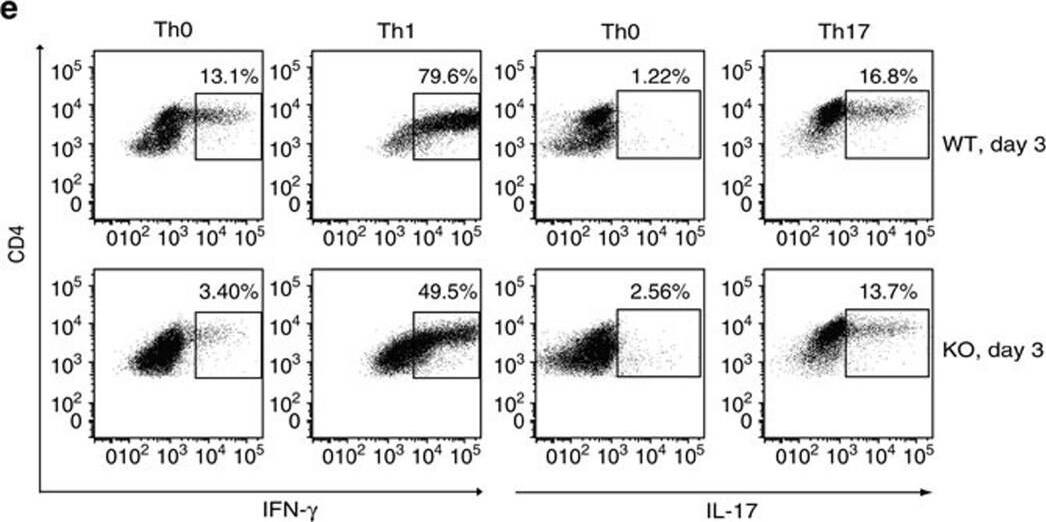Mouse IFN-gamma Antibody
R&D Systems, part of Bio-Techne | Catalog # MAB485


Conjugate
Catalog #
Key Product Details
Species Reactivity
Validated:
Mouse
Cited:
Mouse
Applications
Validated:
CyTOF-ready, Immunohistochemistry, Intracellular Staining by Flow Cytometry, Neutralization, Western Blot
Cited:
Bioassay, ELISA Development, Flow Cytometry, Functional Assay, IHC, In Vivo, Neutralization
Label
Unconjugated
Antibody Source
Monoclonal Rat IgG2A Clone # 37895
Product Summary for Mouse IFN-gamma Antibody
Immunogen
E. coli-derived recombinant mouse IFN-gamma
Specificity
Detects mouse IFN-gamma in Western blots. In Western blots, this antibody does not cross-react with recombinant human (rh) IFN‑ gamma, rrIFN‑ gamma, rpIFN‑ gamma, rrmIFN‑ gamma, rfeIFN‑ gamma, or rcaIFN‑ gamma.
Clonality
Monoclonal
Host
Rat
Isotype
IgG2A
Scientific Data Images for Mouse IFN-gamma Antibody
Detection of IFN‑ gamma in Mouse Splenoctyes by Flow Cytometry.
Mouse splenocytes either (A) stimulated to induce Th1 cells or (B) unstimulated were stained with Rat Anti-Mouse IFN-gamma Monoclonal Antibody (Catalog # MAB485) followed by Phycoerythrin-conjugated Anti-Rat IgG Secondary Antibody (F0105B) and Rat Anti-Mouse CD4 APC-conjugated Monoclonal Antibody (FAB554A). Quadrant markers were set based on control antibody staining (MAB006). To facilitate intracellular staining, cells were fixed with Flow Cytometry Fixation Buffer (FC004) and permeabilized with Flow Cytometry Permeabilization/Wash Buffer I (FC005). View our protocol for Staining Intracellular Molecules.Detection of IFN‑ gamma in Mouse Splenoctyes by Flow Cytometry.
Mouse splenocytes either (A) stimulated for 4 hours with Cell Activation Cocktail 500x (5476) or (B) unstimulated were stained with Rat Anti-Mouse IFN-gamma Monoclonal Antibody (Catalog # MAB485) followed by Phycoerythrin-conjugated Anti-Rat IgG Secondary Antibody (F0105B) and Rat Anti-Mouse CD4 APC-conjugated Monoclonal Antibody (FAB554A). Quadrant markers were set based on control antibody staining (MAB006). To facilitate intracellular staining, cells were fixed with Flow Cytometry Fixation Buffer (FC004) and permeabilized with Flow Cytometry Permeabilization/Wash Buffer I (FC005). Staining was performed using our Staining Intracellular Molecules protocol.IFN‑ gamma Inhibition of EMCV-induced Cytopathy and Neutralization by Mouse IFN‑ gamma Antibody.
Recombinant Mouse IFN-gamma 485-MI) reduces the Encephalomyocarditis Virus (EMCV)-induced cytopathy in the L-929 mouse fibroblast cell line in a dose-dependent manner (orange line), as measured by crystal violet staining. Inhibition of EMCV activity elicited by Recombinant Mouse IFN-gamma (2.5 ng/mL) is neutralized (green line) by increasing concentrations of Rat Anti-Mouse IFN-gamma Monoclonal Antibody (Catalog # MAB485). The ND50 is typically 0.075-0.3 µg/mL.Applications for Mouse IFN-gamma Antibody
Application
Recommended Usage
CyTOF-ready
Ready to be labeled using established conjugation methods. No BSA or other carrier proteins that could interfere with conjugation.
Immunohistochemistry
5-15 µg/mL
Sample: Immersion fixed paraffin-embedded sections of Mouse Spleen
Sample: Immersion fixed paraffin-embedded sections of Mouse Spleen
Intracellular Staining by Flow Cytometry
0.25 µg/106 cells
Sample: Mouse splenocytes stimulated to induce Th1 cells or for 4 hours with Cell Activation Cocktail 500x (5476) were fixed with Flow Cytometry Fixation Buffer (Catalog # FC004) and permeabilized with Flow Cytometry Permeabilization/Wash Buffer I (Catalog # FC005)
Sample: Mouse splenocytes stimulated to induce Th1 cells or for 4 hours with Cell Activation Cocktail 500x (5476) were fixed with Flow Cytometry Fixation Buffer (Catalog # FC004) and permeabilized with Flow Cytometry Permeabilization/Wash Buffer I (Catalog # FC005)
Western Blot
1 µg/mL
Sample: Recombinant Mouse IFN-gamma (Catalog # 485-MI)
Sample: Recombinant Mouse IFN-gamma (Catalog # 485-MI)
Neutralization
Measured by its ability to neutralize IFN-gamma inhibition of EMCV-induced cytopathy in the L-929 mouse fibroblast cell line. Vogel, S. and M. Hogan (1995) in Current Protocols in Immunology. Ciocio, R. (ed); John Wiley & Sons, Inc. p. 6. 9. 1. The Neutralization Dose (ND50) is typically 0.075-0.3 µg/mL in the presence of 2.5 ng/mL Recombinant Mouse IFN-gamma.
Please Note: Optimal dilutions of this antibody should be experimentally determined.
Formulation, Preparation, and Storage
Purification
Protein A or G purified from hybridoma culture supernatant
Endotoxin Level
<0.10 EU per 1 μg of the antibody by the LAL method.
Reconstitution
Reconstitute at 0.5 mg/mL in sterile PBS. For liquid material, refer to CoA for concentration.
Formulation
Lyophilized from a 0.2 μm filtered solution in PBS with Trehalose. *Small pack size (SP) is supplied either lyophilized or as a 0.2 µm filtered solution in PBS.
Shipping
The product is shipped at ambient temperature. Upon receipt, store it immediately at the temperature recommended below. *Small pack size (SP) is shipped with polar packs. Upon receipt, store it immediately at -20 to -70 °C
Stability & Storage
Use a manual defrost freezer and avoid repeated freeze-thaw cycles.
- 12 months from date of receipt, -20 to -70 °C as supplied.
- 1 month, 2 to 8 °C under sterile conditions after reconstitution.
- 6 months, -20 to -70 °C under sterile conditions after reconstitution.
Background: IFN-gamma
Long Name
Interferon gamma
Alternate Names
IFG, IFI, IFNG, IFNgamma
Entrez Gene IDs
Gene Symbol
IFNG
Additional IFN-gamma Products
Product Documents for Mouse IFN-gamma Antibody
Product Specific Notices for Mouse IFN-gamma Antibody
For research use only
